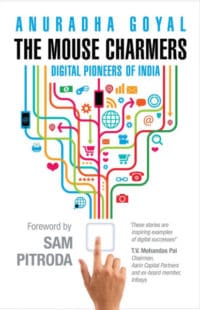RESEARCH: 2/5
WRITING STYLE: 3/5
ENTERTAINMENT QUOTIENT: 3/5
[perfectpullquote align=”full” cite=”” link=”” color=”” class=”” size=””]“When consumers adopt new technologies, they do old things in new ways. When they internalise technology, they begin to do new things.” – James McQuivey[/perfectpullquote]
How many of you book your tickets through IRCTC or Make My Trip or Yatra? How many of you buy your books from Amazon or Flipkart? How many of you use Jabong or Myntra or Zovi for your wardrobe shopping? How many of you use BookMyShow or RedBus?
Though in overall proportion online buyers would be small, the absolute numbers are overwhelming. But this number did not swell in a day. It is the growth story of over a decade; a decade which changed the way we use the Internet, the way we shop.
In “The Mouse Charmers: Digital Pioneers of India”, Anuradha Goyal has attempted to document the tales of a few first-generation Indian companies who have been a part of this glorious growth story through their deep understanding of consumer behaviour and their novel tackling of the Indian psyche.
Anuradha has smartly divided the book into three section – Commerce, Content and Connectors.
Commerce tells the story of online retailers like Flipkart, MakeMyTrip, BigBasket and CaratLane.
Content tells the story of Zomato, Games2Win, ImagesBazaar and Chai with Lakshmi.
Connectors tells the story of Shaadi.com, Rang De, CommonFloor and IndiBlogger.
The introduction to each section gives a brief about the initial problems faced by the entrepreneurs and how they overcame it.
The story of each company is explained neatly by introducing the company, analysing its success story, its USP, its focus on technology, emphasis on customer satisfaction, and brief statistics about the company.
The stories are definitely inspiring and will help you know quite a few things about your favourite e-tailers.
Rashmi Bansal’s “Stay Hungry, Stay Foolish” was the first of such kind of books where the author compiles a list on a subject, and the book is developed on this list.
The devil here lies in the research and the author’s dissection of available information.
The content of “The Mouse Charmers” is mainly sourced from company websites, news articles, or in some cases conversations with the founders.
Though I would have liked to see a few more names included, I understand the space constraint, but the author could have kept the stories shorter. It would have been more interesting to read about the idea or the inspiration behind the solutions to problems than reading only about the solutions themselves.
Anuradha’s writing style is straightforward and free from pretence. It is much easier to focus on and understand the idea this way.
If you are looking for a simple read, you can definitely try this book, but do not expect stories of entrepreneurs or their struggles and moments of glory.
